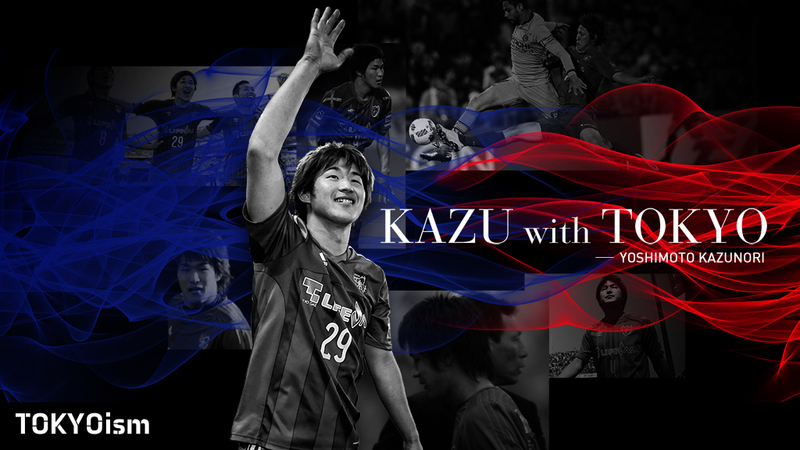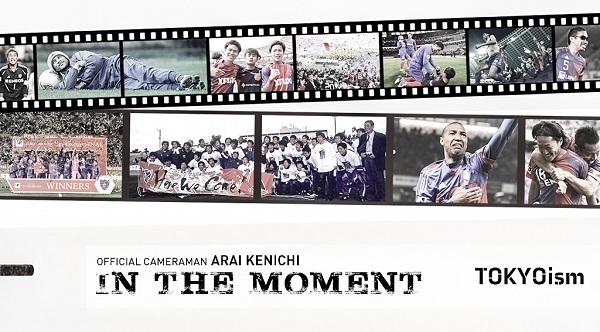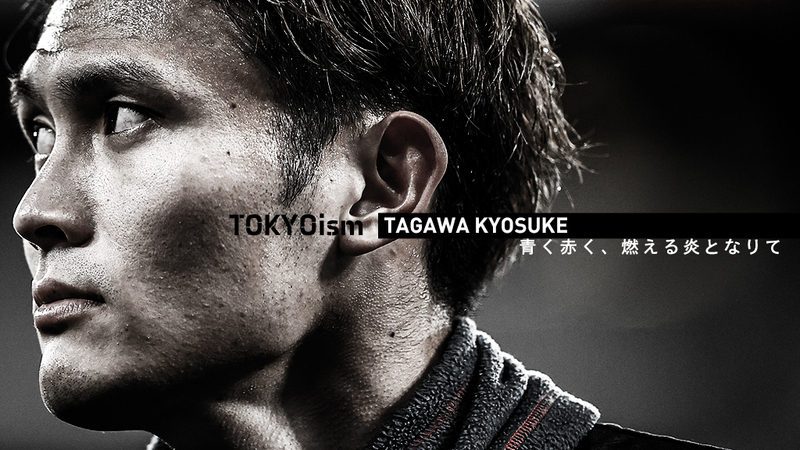The story of a man who continued to fight for playing opportunities until he secured a position in his second life. At his starting point, there was always the blue and red emblem.
KAZU with TOKYO.
When the life of Kazunori YOSHIMOTO intersects with the history of FC Tokyo, the soul resonates and intense emotions are born.
Last Battle of the 2020 Season

On January 25, 2021, at a venue in Ikebukuro, a new organizational structure announcement event was live-streamed online. A young man in a suit, unusually nervous, fumbled his lines while greeting the audience. This season, the strengthening department was divided into the top team management department and the scouting management department. Kazunori YOSHIMOTO was assigned to the latter. Finally, this man, who retired from active duty at Shimizu S-Pulse, returned to his former club FC Tokyo as a newly appointed scout after the month changed.
"I was nervous because I didn't have the image of being in front of people as a staff member. As a player, joking around in front of others is part of the character. But it's different for staff. I was worried about how to behave and felt nervous."
It was a tumultuous year. I joined Shimizu on a full transfer on July 29, 2019, but since then, most of my time has been spent battling injuries.
In September 2019, I was injured and diagnosed with a left knee medial meniscus tear, requiring four months of recovery. After the new year, I underwent a second surgery in February, but the recovery was not satisfactory, and I had to have another surgery in June.
After that, he worked hard on rehabilitation in Shizuoka Prefecture, but both knees, which had undergone years of intense play and repeated surgeries, were in terrible condition. He decided to retire in a state where his output was not improving, announcing it on December 9. Not only FC Tokyo, but also fans and supporters of FC Gifu, Mito Hollyhock, Avispa Fukuoka, and Shimizu were saddened.
However, his season did not end here.
On December 16, I participated for two minutes at the end of the last home game, Sec. 33 against Vegalta Sendai, and it went as planned for the retirement ceremony. However, that was not the only time I was on the field.
"Coach Hiroaki HIRAOKA was considerate and used me at the end of the Sendai match. I thought I had expressed my gratitude for that. However, there was an injury in the same position during the Sendai match, and the coach told me, 'I want you to play in the next match. You are the best option to win right now.' I replied, 'No, I already played in the last match, so I'm fine. I'm already satisfied.'"
The choice to win is yours—after being reminded, Yoshimoto steeled himself.
"Even if my legs break in the end, I will give everything I have."
On December 19, Yoshimoto, who started in the J1 Sec. 34 match against Gamba Osaka held at Panasonic Stadium Suita, played for 71 minutes, contributing to a 2-0 shutout victory and finishing beautifully.
"I never thought I could play to my own satisfaction like that. I was really scared, and I was also thinking about what would happen if we lost 5-0 in the end (laughs), but I felt that everything I had done, including luck, was recognized and that I had earned this victory."
Shouting, raising and lowering the line, putting my body on the line──for about 70 minutes, I made sure to express what I had as my policy, no matter the outcome.
"When I thought this was the last time, I started to cry when I entered the field, and when I was substituted, both the coach and Yoshiyuki SHINODA were crying before I could hold back my tears (laughs). I felt a deep emotion that it was really over."
Thus, Yoshimoto's life as a professional soccer player ended with the passionate tears of hot-blooded men. It was a healthy retirement that brings a smile when reminiscing later. "In my mind, my last match was when I played my best. So I have no regrets... I feel like I was able to give it my all and finish (laughs)," he said.
What was earned through the accumulation up to that point was not only victory and a satisfying performance but also a job after retirement. To stay true to my principles, I first went to FC Tokyo to announce my retirement, where I was offered a job to scout new J-Leaguers for a newly established department. Thus, the final year led to the "Kamikami" announcement on January 25, 2021.
Academy, Supporters, Club Love
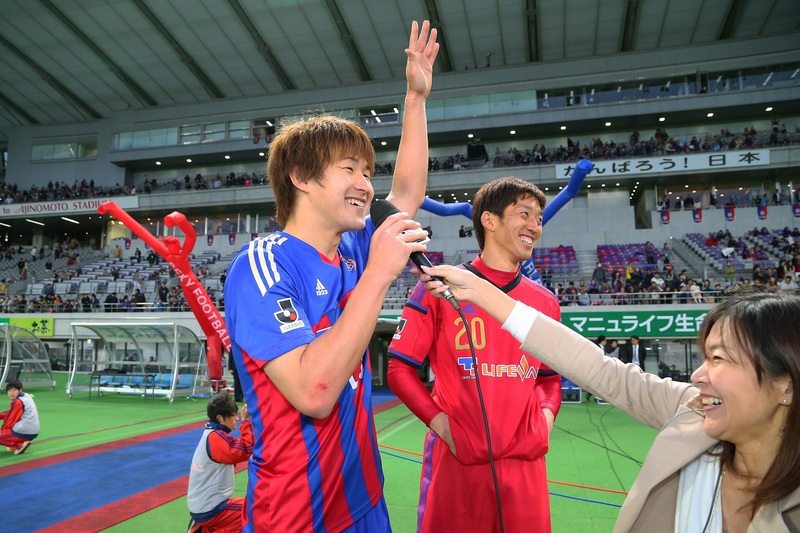
Let's turn back the hands of the clock even further. Yoshimoto started playing soccer at JACPA Tokyo FC, where Ryotaro HIRONAGA, Ryo TAKANO, and Rio OMORI also belonged. The coach later said, "I chose him because he was the fastest and tallest." At first, he wasn't playing in matches. He just enjoyed chasing the ball with everyone.
"I wasn't quiet during my elementary school days (laughs). I liked having fun with everyone, and I also enjoyed goofing around with my friends, and I think there were many people who became close because of that."
After joining FC Tokyo U-15 as a middle school student, I naturally became the captain. I was appointed by the coach, and a sense of responsibility began to grow within me. While playing soccer as a member of the academy, I also started to imitate the supporters.
"When I joined the academy and went to watch a Tokyo (top team) match, the coach at the time took me right to the center of the supporters' area, and I cheered along with the fans. What I learned there, I started doing on my own when I went to watch matches of other age groups, saying, 'Let's cheer!' (laughs) and singing along with them while having fun cheering ourselves. The people in the Tokyo supporters' area can be a bit mischievous, right? I learned the joy of cheering there, even getting scolded a bit for some of the chants (laughs), and I understood the feelings of those who support the team. That was thanks to the coach as well."
There are probably not many clubs where supporters and the academy stand out this much. Yoshimoto, who thrived in the academy, aspired to the top, and shone like the supporters, was truly a child of blue and red.
(Tokyo has its own unique character, and I think that's a good thing. I really feel that there are people who support us, including those who come from the academy. That's why I thought I should do my best for those who cheer for us and buy our uniforms.
In terms of play, it is said that the attitude to fight together had already developed since that time.
"I was undefeated for a long time, and in my second year of middle school, I won the Nike Premier Cup, which was my first national tournament. That's when I realized how strong we were. Even though I didn't know much about soccer at the time, we still managed to win. We hardly lost until the last year. I started to think that we had to win. Because we won for the first time, I always had the awareness that we couldn't lose anywhere. Around my second year of middle school, I thought, even if it's bold to say, that I was the best player in Japan. In my third year of middle school, I participated in a practice match with the top team, and at that moment, I thought I would become a professional by excelling there. Looking back now, I am grateful that the team staff were training me with an eye on my future promotion to the top team."
During my academy days, I thought I couldn't lose to Verdy, who always competes in Tokyo.
"In U-15, it felt like we were playing to defeat Verdy. We were told back then not to lose to Verdy. There are many strong teams now, but Verdy was a special presence."
We must win in a gritty manner, and we cannot lose to Verdy. The feelings of supporting our teammates, the love for the club, and the awareness of connecting with fans and supporters were shaped during the academy days. FC Tokyo, which nurtured Yoshimoto, became the starting point of his football life.
The Birth of 'All Clear' and Thoughts for My Juniors
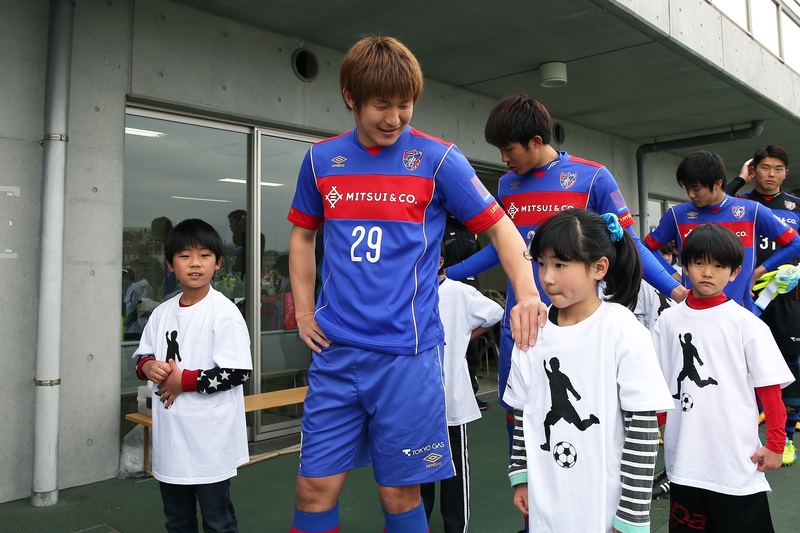
I can't clearly remember when the playing style of 'total erasure,' which involves throwing oneself to defend, began. It may have been like this for a long time, but it's somewhat vague.
"I was just doing what I thought was normal. By putting pressure on the opponent until the end and sliding, the probability of conceding a goal decreases. To put it another way, even just showing your feet can make a difference. In the end, I might be pushed away, but just making my footsteps heard should influence the opponent's actions. If you ask where the origin of this value system comes from, I remember being told a lot of such things by my coach when I was in Gifu, and looking back now, I might have been shaping it while playing in J2 matches."
While repeatedly traveling back and forth between Gifu, where he was on a loan transfer, and Mito, Yoshimoto's gritty defensive style was gradually taking shape. It was named 'All Clear' by a junior who graduated from the academy.
"The term 'all clear' was actually brought up by Hirotaka MITA (laughs). He said, 'Hey, you're clearing all the shooting paths! It's an all clear!' And from there, everyone started saying it (laughs)."

The term took on a life of its own and became established before anyone realized it. Yoshimoto never referred to it as 'all erased' himself. It was a term that spread naturally from the players. In later years, Makoto OKAZAKI referred to Yoshimoto's stopper-like play, characterized by this all erased style, saying that he was influenced by a player whose playing style was completely different from his own. In response, Yoshimoto said, 'Is that really true?' with a wry smile. It seemed he was doubtful whether that junior truly thought that way from the bottom of his heart.
"I'm glad to hear you say that, but... I haven't really done anything special; I've just occasionally given advice or talked a bit."
If we trust Okazaki's words, it means he grew up watching Yoshimoto's back, or he was naturally influenced by breathing the same air as Yoshimoto.
"What I remember is when we went on an away trip in J3. At that time, the over-age (OA) players basically had single rooms. But for some reason, I ended up sharing a room with Makoto OKAZAKI (laughs). 'Wait!? Everyone else has single rooms, right?' I was quite unsettled. Moreover, Makoto goes to bed really early (laughs), so I was wondering why I had to be considerate of him—"
Okazaki, who does not break his own pace, seemed to have a mysterious personality to Yoshimoto, who is a generation older, and it appears he was constantly perplexed about how to communicate with him. In his difficult-to-read heart, Okazaki must have been grateful to Yoshimoto. Despite being younger, Yoshimoto was kind and considerate towards his junior teammates.
"Mako is the player who surprised me the most with his speed of growth. He basically played in all the J3 matches, and when we occasionally played together in J3, I noticed changes even within those few weeks. I realized that players can grow this much in such a short period, which is amazing. As a result, I played soccer with Okazaki at Shimizu S-Pulse, and I feel a real connection with him. I care about him and sincerely hope he does well. Okazaki is a really cute junior."
The work of the player representative who improved communication

Yoshimoto, who dramatically increased his playing opportunities from the 2014 season, became the face of Tokyo. He began serving as the players' association president in the 2015 season, and in 2017, he appeared on the cover of the pamphlet 'Why Not Come to Kodaira?' as the tourism ambassador for Kodaira City. Recognized for his performance through a complete reset, Yoshimoto was acknowledged not only for his skills but also for his character, truly recognized as a man of Tokyo. The sense of responsibility cultivated during his youth and his innate sociability began to show even in the professional arena.
"As I became able to participate in matches consistently and gained recognition from those around me, my confidence grew, and my statements became more persuasive. More people started to listen to me. Throughout this process, I became more aware of how to improve the team. I wondered how we could make the team stronger and create a greater sense of unity within the club. I felt a responsibility to lead as a player from the academy, and I think it was great that I was able to build a cooperative relationship with everyone."
Yojiro TAKAHAGI, who joined in the 2017 season, says that the contribution of the then president Yoshimoto is behind the functioning of the players' association.
"Takahagi has experience with various teams and has won championships, so I wanted to incorporate different things. I have consulted with him more often, and he has helped me a lot."
Once a month, a meeting is held between the representatives of the players and the club to check the situation. Communication has improved, and the club and team have become more united. For example, when a player requested, "I want to be able to eat after practice at the clubhouse," this was communicated to the club, and if it could be realized, Yoshimoto would tell the players, "You absolutely have to eat it," and made sure it was enforced. "Since we said it, let's make sure we do it properly ourselves; it's just a basic thing as human beings that we need to confirm again," Yoshimoto said.
"I was very conscious of trying to create an open environment to benefit the team."
I had the players come 15 minutes earlier than usual before practice to convey the requirements. We decided on the parking location and established rules for the players' association—this was when Yoshimoto became a man who could also handle off-pitch work.
Repeated transfers. Gifu, Mito, Fukuoka, Shimizu

However, ironically, as he matured, his opportunities to play decreased. In the later years of his career, Yoshimoto sought a place to fight outside of FC Tokyo once again. In the summer of 2018, he was loaned to Fukuoka, and a year later, he joined Shimizu on a permanent transfer. However, it is said that his stance did not change during these two transfers, just as it did when he departed for Gifu and Mito.
"Until I was about 25, I had only signed one-year contracts, and I played thinking I would be cut. I had the desire to return to Tokyo and succeed, but I also wanted to prove myself here, and I thought that if I didn't do that, I wouldn't be able to continue playing soccer."
Yoshimoto, who had no experience playing throughout the season, learned to maintain his condition in a situation where he played every week at his first loan destination, Gifu. It was not only about physical condition but also about how to approach each match with the right mindset. By putting pressure on himself and living each day as if it were a gamble, he was able to grow mentally. He still takes pride in achieving the Emperor's Cup quarter-finals with the motivation to leave his name in the club's history. Yoshimoto met his wife, who was working at a training gym reception in this area, and later married her. "Well, it was a good transfer," he says, and his face is particularly cheerful as he recounts this episode.
In Mito, he scored the decisive goal in his first match after the transfer, the J2 Sec. 29 match against Oita Trinita, leading to a 2-1 victory. However, he was immediately injured in the following week's Sec. 30 match, diagnosed with an 8-month recovery period, ending his challenge here after just two matches. Nevertheless, his encounter with coach Tetsuji HASHIRATANI has become an asset to him up to the present. The same can be said about his meeting with coach Masami IHARA in Fukuoka. Their influence, having played as center-backs during their active careers and now facing responsibilities as professional coaches, has certainly been significant.
"Mr. Hashiratani and Mr. Igahara, meeting with the two coaches who played the same position and served as captains for the Japan national team was truly significant. Both of them are kind, passionate, and have helped me a lot. I learned a lot from them."
When I transferred to Fukuoka, I still had a contract with Tokyo. If there were no offers by the time my contract expired, it would lead to immediate retirement. In order to prove that I can play at a level suitable for professional matches while accumulating achievements, I needed a place to showcase my skills.
"I have never transferred with the assumption of returning to Tokyo, whether it was Gifu or Mito. I went to Fukuoka with the intention of putting down roots there, and I faced soccer with the belief that my mission was to leave as much as I could for the team I transferred to. Even now, I feel sorry that I couldn't help Fukuoka get promoted to J1 in 2018."
The club you belong to at any given time is always the first, and you pour your love into each and every club - maintaining that priority and upholding your principles.
"I have never thought of it as being for Tokyo while I am with S-Pulse. If S-Pulse were a club that said 'Do not wear anything blue and red,' then I would do that."
What sets Gifu, Mito, Fukuoka, Shimizu, and Tokyo apart is that they are clubs nurtured from the academy. They are like a home to me. At each transfer destination, there are different relationships, and meeting many people has enriched my life.
And once again, KAZU intersects with TOKYO

Why did Yoshimoto, who has swum through the world of professional soccer not only in Tokyo, start his second life at FC Tokyo?
"The first thing I need to do is announce my retirement in Tokyo."
In order to be consistent, Yoshimoto was thinking this way. He had previously informed Gifu, Mito, Fukuoka, and Shimizu that "we need to greet Tokyo, so if we find ourselves in trouble (without anything happening there), please help us." Even so, perhaps out of concern, Shimizu's GM Kiyoshi OKUMA called every few days to ask, "What happened?" It was said that a voice from the other end of the line said, "If anything happens, just come to me."
"I never thought I would say to Mr. Okuma that I am retiring from S-Pulse. When I joined the Tokyo academy, Mr. Okuma was the head coach of the top team, so I wondered if there is such a fate that brings us together."
After the Levain Cup final on January 4, 2021, I greeted FC Tokyo President Naoki Okane. The position offered to Yoshimoto, who had no thoughts of becoming a coach due to severe knee pain, was in the scouting management department. President Okane requested, "I want you to discover and develop players who will become the second Yoshimoto," and Yoshimoto accepted it.
"To be honest, even if I'm not here right now, the team will probably keep going. But the president created a place for me to work, so I thought I wanted to work for the club in return. Until then, I honestly hadn't decided on my path. But since the president said that, I agreed on the spot and talked with my direct supervisor, Yutaka ISHII, and signed the contract."
Once it was decided that I would become a scout, I consulted with Naotake HANYU, who had the same experience in the profession. He was a trusted senior figure, having appeared together in talk shows during my time as a player, and we would discuss various matters over meals. After that, through consultations with many people including Naohiro ISHIKAWA, my approach to the scouting role within Yoshimoto began to take shape.
"What I value is the comparison with the academy players. If they are better, then it's wrong to bring in players from elsewhere for the sake of my own work and achievements. If there are no players better than the academy players, then it's fine to say 'there are none,' and I believe that being able to confidently say 'there are none' is what being a professional is all about."
Director Ishii and Scout Toshiki Koike both spent their playing careers during the Tokyo Gas era and are knowledgeable about the club's history. On the other hand, Scout Hiroshi Tsukamoto, who has been in coaching for a long time, has experience teaching Shuichi Gonda and Hirotaka Mita at the school. Yoshimoto, who grew up in Tokyo, respects his long-time colleagues and has begun the fight as a staff member to make Tokyo a stronger and more beloved team.
"Why do I love Tokyo? It's the same as asking, 'Why do I love my children or my parents?'"
Recalling the blue and red spirit filled to the brim, "KAZU" starts a new career here in Tokyo.
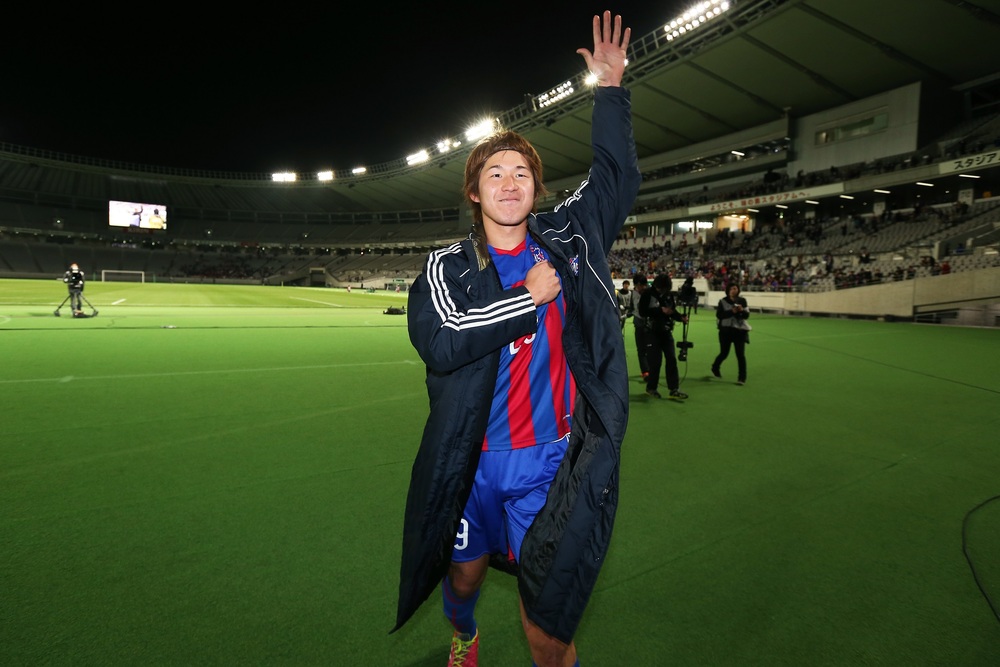
Kazunori YOSHIMOTO Profile
A graduate of FC Tokyo's academy. Made his professional debut with FC Tokyo in 2007 and retired from active play in 2020.
Currently, after retirement, I belong to the Scouting Management Department of FC Tokyo.
Text by Masaru Goto
photo by Kenichi Arai
